Valley of the Kings: A Visit to Luxor’s Ancient Necropolis
This destination guide covers a visit to the famous tombs of the Valley of the Kings, the ancient Egyptian necropolis near Luxor.
Last morning in Luxor
After exploring the awe-inspiring ancient Egyptian archaeological sites of Karnak and Luxor Temple, I enjoyed one final night on board my Nile cruise ship, the M/S Princess Sarah.
Despite my Nile cruise itinerary coming to an end, there was still a morning programme planned for the next day.
Together with my knowledgeable guide Mohammed, I would be visiting the west bank sights of Luxor, including the Valley of the Kings and the Temple of Hatshepsut.
Once more, Mohammed and I made the decision to set out early at the break of dawn so we could avoid the crowds and have the narrow tombs inside the Valley of the Kings all to ourselves.



Valley of the Kings
After checking out from the ship, I stowed my bags in our private car and we set off from our east bank mooring to the Valley of the Kings on the west bank of the Nile.
Having purchased our entrance tickets, we entered the tranquil mountain valley, pleasantly surprised to find it completely devoid of other visitors.
The Valley of the Kings served as the burial ground for Egypt’s mighty pharaohs, and its magnificent and mysterious tombs rank among the most popular attractions in the country for tourists to visit.
So far 65 tombs have been discovered in the Valley of the Kings, although not all of them are open to visitors or even fully excavated.
A ticket to the Valley of the Kings grants access to three tombs of your choice, except for the tomb of Tutankhamun, as his tomb requires an additional ticket for entry.
Although the tomb of Tutankhamun is one of the most famous, it isn’t the most spectacular nor the largest of the dozens of tombs in the Valley of the Kings.
I therefore followed the recommendations of my guide Mohammed on which tombs were the most beautiful and interesting to visit.
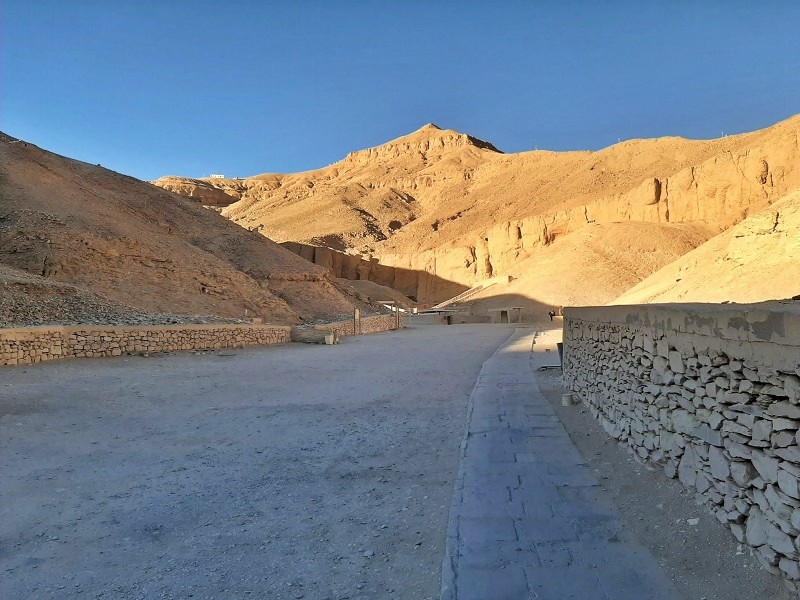

Tomb of Ramses III
I began my visit to the Valley of the Kings by exploring the Tomb of Ramses III, designated as site KV11 by archaeologists.
Walking into an ancient Egyptian tomb for the first time is incredibly exciting, as it almost makes you feel like you are a modern-day Howard Carter.
The tomb of Ramses III is an impressive 188 meters (617 ft) long, and you can’t help but be amazed by the tremendous work it took to carve it out of the rock.
The hieroglyphs and images on the walls depict ancient Egyptian funerary texts such as the Litany of Re.
This funerary text was specifically intended for the tombs of pharaohs and the upper echelons of nobility and served the crucial purpose of guiding their spirits on their journey into the afterlife.
To be precise, the Litany of Re invokes different forms of the Egyptian sun god Ra or Re, with a special focus on the symbolic union of the gods Re and Osiris, and the identification of the deceased king with them.



Decorations and symbolism
It’s well-worth to pause for a minute inside the tomb to admire the magnificent decorations, especially those on the ceiling.
The delicate pattern adorning the ceiling symbolises a serene blue sky adorned with white stars.
Some scenes depicted on the walls are also exquisitely crafted, showcasing striking red and blue colours that have remained intact over time.
You can for example see an image where Ramses III offers a small statue of the goddess Maat to Osiris, the lord of the underworld.
Another image depicts the four sons of Horus, namely Imsety, Hapy, Duamutef and Qebehsenuef.
The canopic jars, utilized by the ancient Egyptians during the mummification process to preserve the pharaoh’s organs for the afterlife, were adorned with lids representing the four sons of Horus.
For example, the canopic jar with the monkey-headed lid of Hapy had the purpose of safeguarding the removed lungs of the deceased.
In the same way, the jar of Qebehsenuef with his falcon head was used to store the removed intestines.

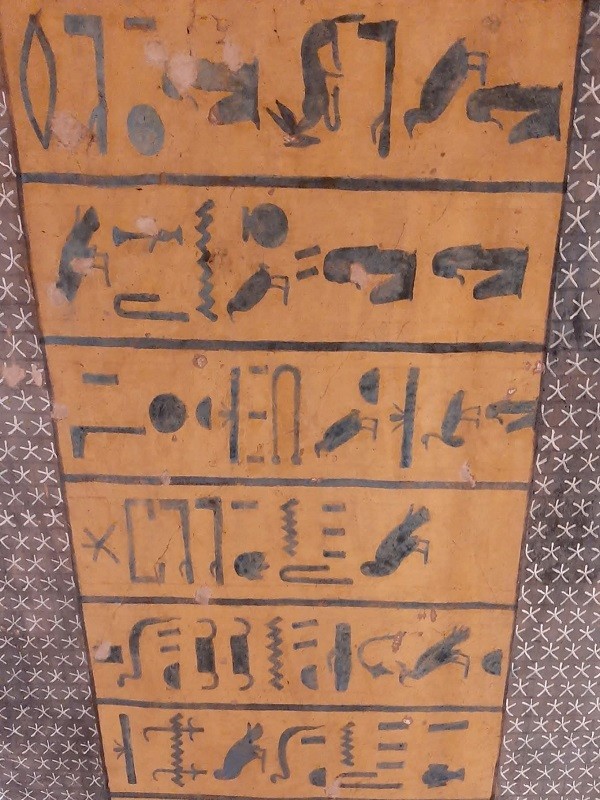


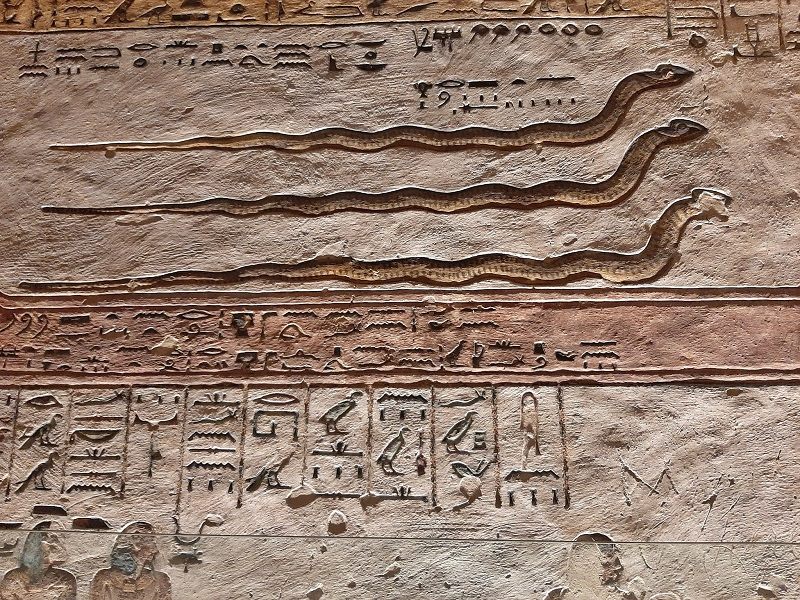

Passage to the afterlife
Besides the Litany of Re, some other funerary texts were used as well in the Tomb of Ramses III, such as the Book of the Dead and the Book of Gates.
For example, you can see a funerary composition from the Book of Gates in the Tomb of Ramses III, featuring giant serpents guarding some portals where the sun must pass through.
The journey of the sun through the underworld during nighttime hours symbolises the passage of the soul to the afterlife.
Demons can be observed either aiding or hindering the funerary barge on its passage to the afterlife.


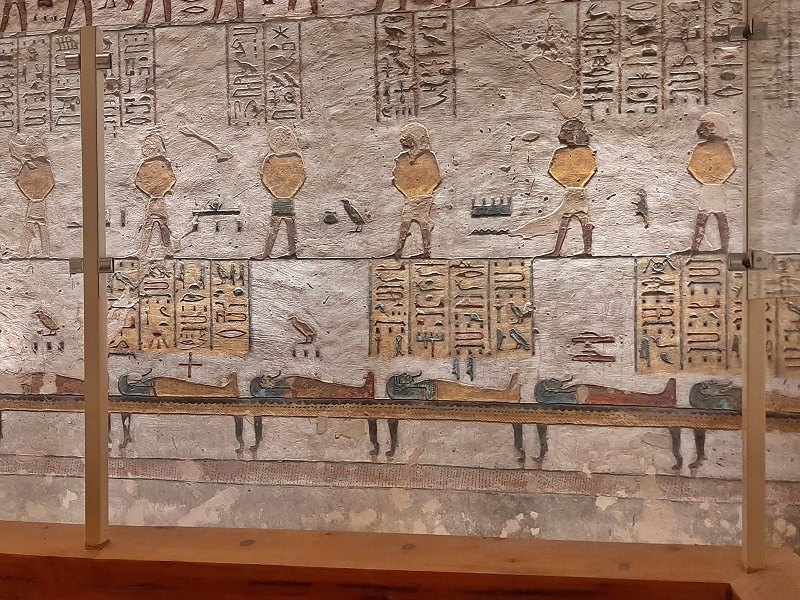
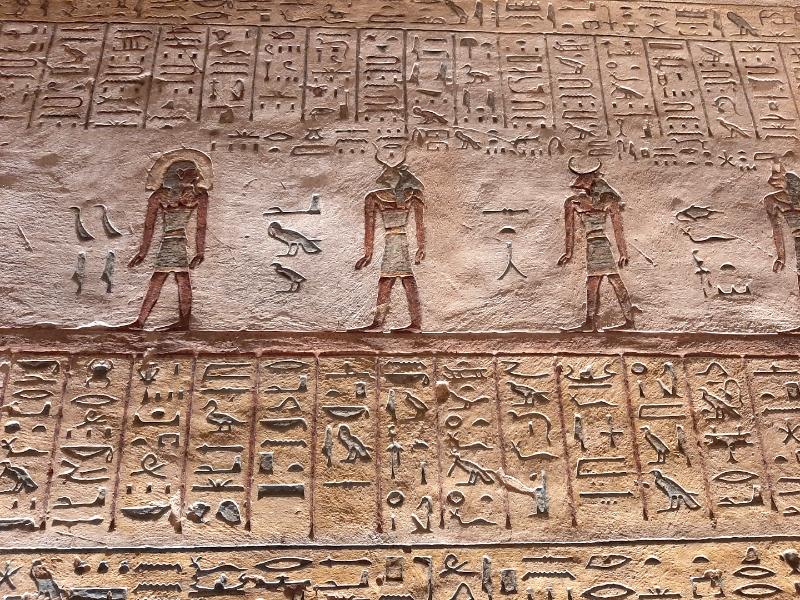
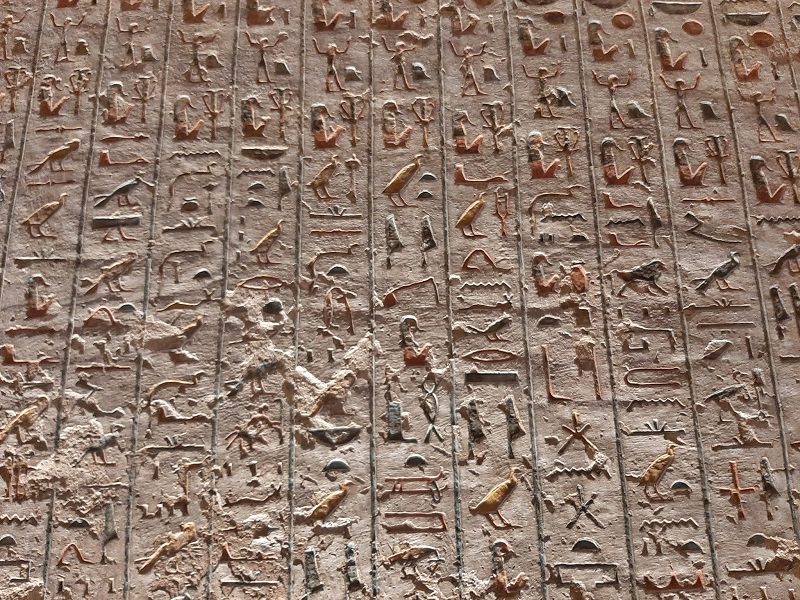
Tomb of Ramses IX
Next on my visit to the Valley of the Kings was the Tomb of Ramses IX, also known as archaeological site KV6.
Compared to the previous tomb I visited, the Tomb of Ramses IX has a significantly wider entrance, although at a length of 105 metres (344 ft) it isn’t nearly as long.
Thanks to the wide passage and gentle slope of the shaft, it’s one of the more accessible and thus popular tombs in the Valley of the Kings, especially among tour groups.
Fortunately, there still weren’t any crowds around and I again had the entire tomb to myself.
Just like the Tomb of Ramses III, the Tomb of Ramses IX has been known and fully accessible since antiquity and is not a more recent discovery like the Tomb of Tutankhamun, which Howard Carter famously unearthed in 1922.
Because of this, you can see ancient graffiti left on the walls by Roman and early Coptic Christian visitors.
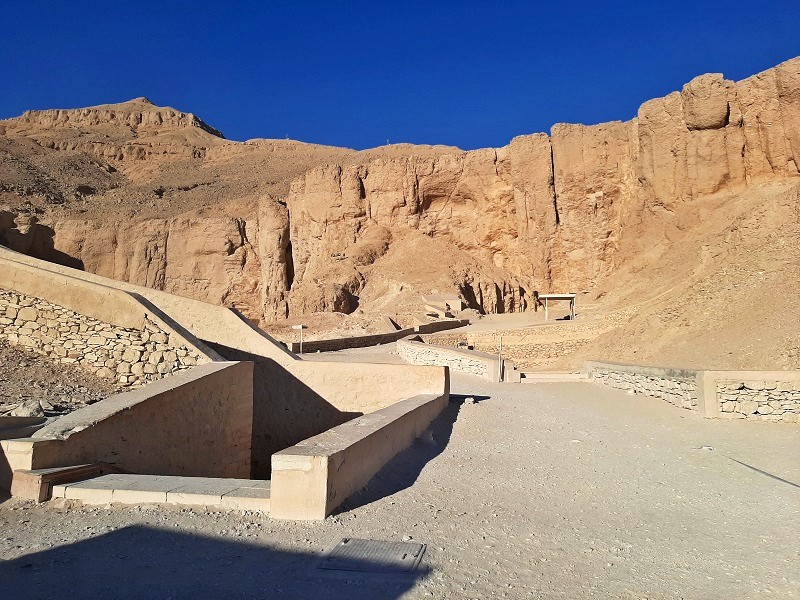


Inside the Tomb of Ramses IX
Although the Tomb of Ramses IX was only half-finished at the time of the Pharaoh’s passing, its paintings and decorations are relatively well-preserved because it was the last one in the Valley of the Kings to be completed.
The hieroglyphs and images again come from ancient Egyptian funerary texts such as the Book of Caverns, Book of Dead and the Book of the Earth.
At the far end of the tomb you can find the burial chamber that once held the sarcophagus of Ramses IX.
On the ceiling of the burial chamber you can find two magnificent images of the sky goddess Nut, as well as scenes from the Book of the Heavens.
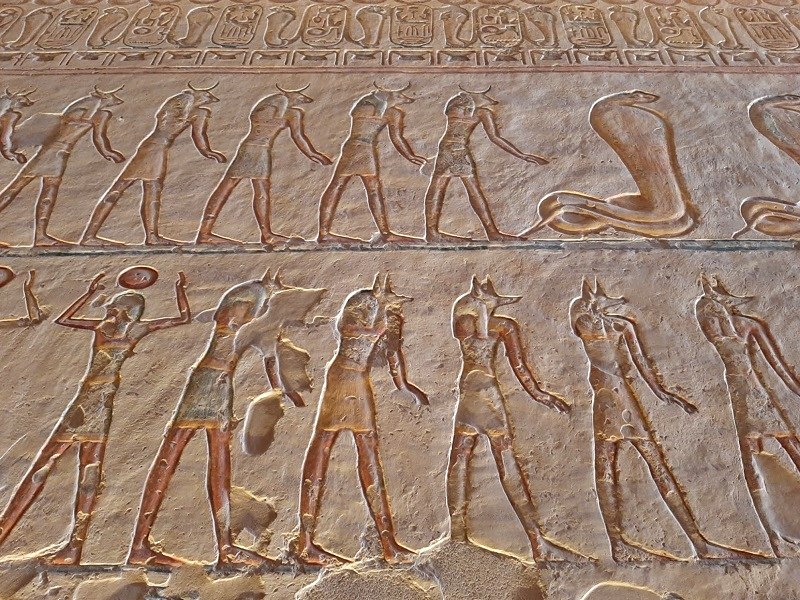





Tomb of Pharaoh Merenptah
During my visit to the Valley of the Kings, the third and last tomb I explored was the Tomb of Pharaoh Merenptah, designated as archaeological site KV8.
It’s the second-largest tomb in the Valley of the Kings and has a total length of 165 metres (541 ft).
The lower parts of the shaft’s decorations have suffered significant damage in many places due to floods.
However, there is still some striking imagery to admire in the tomb, such as a colourful yellow relief depicting Pharaoh Merenptah and Ra-Horakhty.






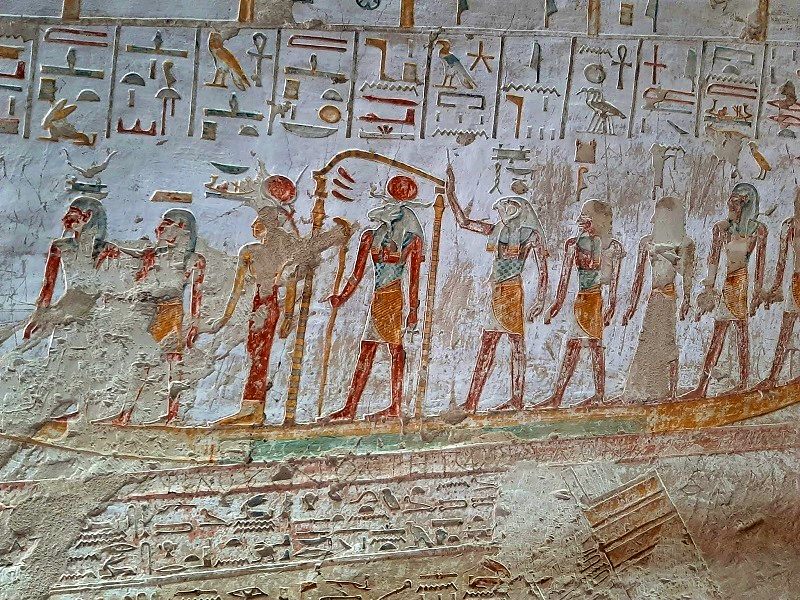

Burial chamber of the Tomb of Merenptah
Upon reaching the burial chamber at the end of the tomb, you will immediately notice its impressive size and volume.
Pharaoh Merenptah was originally laid to rest within a set of four stone sarcophagi, three of which were crafted from granite, and the fourth and innermost one made of alabaster.
However, the Egyptian architects and builders made a rare mistake, as the outermost sarcophagus turned out to be too wide for the entrance, which meant that part of the gates had to be hacked away.
On the top of the wall, right next to the sarcophagus, you can observe the final scene from the Book of Caverns.
This funerary text narrates the voyage of the sun god Ra through the underworld, depicting the rewards for the righteous and the punishments for those who do not pass judgment in the afterlife.






Conclusion
The Valley of the Kings, an ancient Egyptian necropolis located just outside Luxor, is one of Egypt’s most famous sights and a delightful place to visit.
The Valley of the Kings functioned as the final resting place for Egypt’s pharaohs such as Ramses III and Tutankhamun.
With an entry ticket, you have the opportunity to visit three tombs of your choice, and I opted for the tombs of Pharaoh Ramses III, Ramses IX and Merenptah.
Just like the interior of Egyptian temples, these tombs feature magnificent decorations full of symbolism, which were meant to guide the spirits of the pharaohs to the afterlife.
If you visit the Valley of the Kings in the early morning you are likely to have the tombs all to yourself, making you feel like a modern-day Howard Carter when you explore them.
Trip report index
This article is part of the ‘Walk Like an Egyptian: A Grand Tour of Egypt‘ trip report, which consists of the following chapters:
1. Red-Eye Ramblings of a Late Night Flight to Cairo
2. A Visit to the Pyramids of Giza by Camel
3. Review: Sofitel Nile El Gezirah, Zamalek, Cairo
4. Exploring the Medieval Old Town and Islamic History of Cairo
5. Visiting the Museum of Egyptian Antiquities in Cairo
6. Mar Girgis: The Churches of Christian Old Cairo
7. Review: Ernst Watania Sleeping Train Cairo to Aswan
8. The Ancient Quarry of Aswan and the Unfinished Obelisk
9. A Boat Ride From Aswan to the Temple of Isis at Philae
10. A Visit to the Aswan High Dam and Lake Nasser
11. A Visit to the Nubian Village on Aswan’s Elephantine Island
12. Aswan Guide: A Visit to Egypt’s Most Stunningly Located City
13. A Half Day Trip From Aswan to Amazing Abu Simbel
14. Nile River Cruise Guide: All Info for Your Egypt Boat Trip
15. Review: M/S Princess Sarah Nile River Cruise Ship
16. Nile Cruise: Sailing From Aswan to Kom Ombo
17. A Visit to the Ancient Crocodile Temple of Kom Ombo
18. A Visit to the Temple of Horus at Edfu
19. Nile Cruise: Sailing From Edfu to Luxor
20. Luxor, Egypt: Visiting the Sights of Ancient Thebes
21. A Visit to Luxor’s Giant Temple Complex of Karnak
22. Visitor Guide to Wonderful Luxor Temple
23. Valley of the Kings: A Visit to Luxor’s Ancient Necropolis (current chapter)
24. The Temple of Hatshepsut: A Visit to a Unique Mortuary Temple
25. Review: Sofitel Winter Palace Hotel, Luxor, Egypt
26. Review: Daytime Train Luxor to Cairo, Egypt
27. Review: Steigenberger Hotel El Tahrir, Cairo
28. A Visit to the Pyramid of Djoser and the Saqqara Necropolis
29. A Visit to the Dahshur Pyramid Complex
30. Memphis: Exploring the Old Capital of Ancient Egypt
31. From Cairo to Alexandria by Train: My Travel Experience
32. Review: Paradise Inn Le Metropole Hotel, Alexandria, Egypt
33. Alexandria: A Visit to Egypt’s Historic Mediterranean Port City
34. Egypt: Impressions and Reflections After My Two Week Trip
35. Epilogue: Safety and How to Deal With Street Hassle in Egypt

